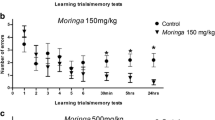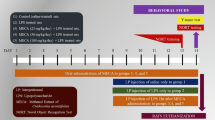Abstract
Male Wistar rats were subjected to chronic 6-hydroxy-l-nicotine treatment (6HLN, 0.3 mg/kg, i.p., seven consecutive days) and their memory performance was studied by means of Y-maze and radial arm-maze tasks. 6HLN significantly increased spontaneous alternations in Y-maze task and working memory in radial arm-maze task, suggesting effects on short-term memory, without affecting long-term memory, explored by reference memory in radial arm-maze task. In addition, 6HLN increased antioxidant enzymes activity and decreased production of lipid peroxidation, suggesting antioxidant effects. Also, the linear regression between behavioral measures and oxidative stress markers resulted in significant correlations. Therefore, positive effects of 6HLN on spatial memory may occur by antioxidant actions.






Similar content being viewed by others
References
Alkadhi KA, Srivareerat M, Tran TT (2010) Intensification of long-term memory deficit by chronic stress and prevention by nicotine in a rat model of Alzheimer’s disease. Mol Cell Neurosci 45:289–296
Barr J, Sharma CS, Sarkar S, Wise K, Dong L, Periyakaruppan A, Ramesh GT (2007) Nicotine induces oxidative stress and activates nuclear transcription factor kappa B in rat mesencephalic cells. Mol Cell Biochem 297:93–99
Bradford MM (1976) A rapid and sensitive for the quantitation of microgram quantitites of protein utilizing the principle of protein-dye binding. Anal Biochem 72:248–254
Brandsch R (2006) Microbiology and biochemistry of nicotine degradation. Appl Microbiol Biotechnol 69:493–498
Buccafusco JJ, Shuster LC, Terry JAV (2007) Disconnection between activation and desensitization of autonomic nicotinic receptors by nicotine and cotinine. Neurosci Lett 413:68–71
Celie PH, van Rossum-Fikkert SE, van Dijk WJ, Brejc K, Smit AB, Sixma TK (2004) Nicotine and carbamylcholine binding to nicotinic acetylcholine receptors as studied in AChBP crystal structures. Neuron 41:907–914
Chattopadhyay K, Chattopadhyay BD (2008) Effect of nicotine on lipid profile, peroxidation and antioxidant enzymes in female rats with restricted dietary protein. Indian J Med Res 127:571–576
Ciobica A, Hritcu L, Artenie V, Stoica B, Bild V (2009) Effects of 6-OHDA infusion into the hypothalamic paraventricular nucleus in mediating stress-induced behavioral responses and oxidative damage in rats. Acta Endo (Buc) 5:425–436
Crooks PA, Li M, Dwoskin LP (1997) Metabolites of nicotine in rat brain after peripheral nicotine administration. Cotinine, nornicotine, and norcotinine. Drug Metab Dispos 25:47–54
Dome P, Lazary J, Kalapos MP, Rihmer Z (2010) Smoking, nicotine and neuropsychiatric disorders. Neurosci Biobehav Rev 34:295–342
Doolittle DJ, Winegar R, Lee CK, Caldwell WS, Hayes AW, de Bethizy JD (1995) The genotoxic potential of nicotine and its major metabolites. Mutat Res 344:95–102
Emilien G, Beyreuther K, Masters CL, Maloteaux JM (2000) Prospects for pharmacological intervention in Alzheimer disease. Arch Neurol 57:454–459
Hefco V, Yamada K, Hefco A, Hritcu L, Tiron A, Olariu A, Nabeshima T (2003) Effects of nicotine on memory impairment induced by blockade of muscarinic, nicotinic and dopamine D2 receptors in rats. Eur J Pharmacol 474:227–232
Hritcu L, Nabeshima T (2009) Kainic acid lesion-induced spatial memory deficits of rats. Cent Eur J Biol 4:179–185
Hritcu L, Clicinschi M, Nabeshima T (2007) Brain serotonin depletion impairs short-term memory, but not long-term memory in rats. Physiol Behav 91:652–657
Hritcu L, Ciobica A, Gorgan L (2009) Nicotine-induced memory impairment by increasing brain oxidative stress. Cent Eur J Biol 4:335–342
Jarrard LE, Davidson TL, Bowring B (2004) Functional differentiation within the medial temporal lobe in the rat. Hippocampus 14:434–449
Karelson E, Bogdanovic N, Garlind A, Winblad B, Zilmer K, Kullisaar T, Vihalemm T, Kairane C, Zilmer M (2001) The cerebrocortical areas in normal brain aging and in Alzheimer’s disease: noticeable differences in the lipid peroxidation level and in antioxidant defense. Neurochem Res 26:353–361
Leite TB, Gomes D, Miteva M, Chomilier J, Villoutreix B, Tuffery P (2007) Frog: a FRee Online druG 3D conformation generator. Nucleic Acids Res 35:W568–W572
Maier CM, Chan PH (2002) Role of superoxide dismutases in oxidative damage and neurodegenerative disorders. Neuroscientist 8:323–334
Marks MJ, Romm E, Campbell SM, Collins AC (1989) Variation of nicotinic binding sites among inbred strains. Pharmacol Biochem Behav 33:679–689
Maurice T, Lockhart BP, Privat A (1996) Amnesia induced in mice by centrally administered beta-amyloid peptides involves cholinergic dysfunction. Brain Res 706:181–193
Morris GM, Goodsell DS, Halliday RS, Huey R, Hart WE, Belew RK, Olson AJ (1998) Automated docking using a Lamarckian genetic algorithm and an empirical binding free energy function. J Comput Chem 19:1639–1662
Noor R, Mittal S, Iqbal J (2002) Superoxide dismutase-applications and relevance to human diseases. Med Sci Monit 8:RA210–RA215
O’Leary K, Parameswaran N, McIntosh JM, Quik M (2008) Cotinine selectively activates a subpopulation of alpha3/alpha6beta2 nicotinic receptors in monkey striatum. J Pharmacol Exp Ther 325:646–654
Ohkawa H, Ohishi N, Yagi K (1979) Assay for lipid peroxides in animal tissues by thiobarbituric acid reaction. Anal Biochem 95:351–358
Padurariu M, Ciobica A, Hritcu L, Stoica B, Bild W, Stefanescu C (2010) Changes of some oxidative stress markers in the serum of patients with mild cognitive impairment and Alzheimer’s disease. Neurosci Lett 469:6–10
Pogocki D, Ruman T, Danilczuk M, Danilczuk M, Celuch M, Wałajtys-Rode E (2007) Application of nicotine enantiomers, derivatives and analogues in therapy of neurodegenerative disorders. Eur J Pharmacol 563:18–39
Potter A, Corwin J, Lang J, Piasecki M, Lenox R, Newhouse PA (1999) Acute effects of the selective cholinergic channel activator (nicotinic agonist) ABT-418 in Alzheimer’s disease. Psychopharmacology 142:334–342
Riveles K, Huang LZ, Quik M (2008) Cigarette smoke, nicotine and cotinine protect against 6-hydroxydopamine-induced toxicity in SH-SY5Y cells. Neurotoxicology 29:421–427
Sandu C, Chiribau CB, Brandsch R (2003) Characterization of HdnoR, the transcriptional repressor of the 6-hydroxy-D-nicotine oxidase gene of Arthrobacter nicotinovorans pAO1, and its DNA binding activity in response to L- and D-nicotine derivatives. J Biol Chem 278:51307–51315
Sanner MF (1999) Python: a programming language for software integration and development. J Mol Graph Model 17:57–61
Schuessel K, Leutner S, Cairns NJ (2004) Impact of gender on upregulation of antioxidant defence mechanisms in Alzheimer’s disease brain. J Neural Transm 11:1167–1182
Sharma M, Gupta YK (2002) Chronic treatment with trans resveratrol prevents intracerebroventricular streptozotocin induced cognitive impairment and oxidative stress in rats. Life Sci 7:2489–2498
Sudheer AR, Kalpana C, Srinivasan M, Menon VP (2005) Ferulic acid modulates altered lipid profiles and prooxidant/antioxidant status in circulation during nicotine-induced toxicity: a dosedependent study. Toxicol Mech Method 15:375–381
Suleyman H, Gumustekin K, Taysi S, Keles S, Oztasan N, Aktas O (2002) Beneficial effects of Hippophae rhamnoides L. on nicotine induced oxidative stress in rat blood compared with vitamin E. Biol Pharm Bull 25:1133–1136
Sultana R, Piroddi M, Galli F, Butterfield DA (2008) Protein levels and activity of some antioxidant enzymes in hippocampus of subjects with amnestic mild cognitive impairment. Neurochem Res 33:2540–2546
Titus ADJ, Shankaranarayana BS, Harsha HN, Ramkumar K, Srikumar BN, Singh SB, Chattarji S, Raju TR (2007) Hypobaric hypoxia-induced dendritic atrophy of hippocampal neurons is associated with cognitive impairment in adult rats. Neuroscience 145:265–278
Ulens C, Akdemir A, Jongejan A, van Elk R, Bertrand S, Perrakis A, Leurs R, Smit AB, Sixma TK, Bertrand D, de Esch IJP (2009) Use of acetylcholine binding protein in the search for novel alpha 7 nicotinic receptor ligands. In silico docking, pharmacological screening, and X-ray analysis. J Med Chem 52:2372–2383
Valdivia A, Pérez-Álvarez S, Aroca-Aguilar J, Ikuta I, Jordán J (2009) Superoxide dismutases: a physiopharmacological update. J Physiol Biochem 65:195–208
Wilson AL, Langley LK, Monley J, Bauer T, Rottunda S, McFalls E, Kovera C, McCarten JR (1995) Nicotine patches in Alzheimer’s disease: pilot study on learning, memory, and safety. Pharmacol Biochem Behav 51:509–514
Winterbourn C, Hawkins R, Brian M, Carrell R (1975) The estimation of red cell superoxide dismutase activity. J Lab Clin Med 85:337
Yildiz D (2004) Nicotine, its metabolism and an overview of its biological effects. Toxicon 43:619–632
Yusuf S, Adelaiye BA, Agunu A (2009) Effect of Ziziphus mauritiania (L.) seed extracts on spatial recognition memory of rats as measured by the Y-maze test. J Nat Prod 2:31–39
Acknowledgments
Marius Mihasan was supported by CNCSIS-UEFISCSU, project number PN-II-RU 337/2010.
Author information
Authors and Affiliations
Corresponding author
Additional information
Lucian Hritcu, Marius Stefan, and Marius Mihasan equally contributed to this work
Rights and permissions
About this article
Cite this article
Hritcu, L., Stefan, M., Brandsch, R. et al. 6-hydroxy-l-nicotine from Arthrobacter nicotinovorans sustain spatial memory formation by decreasing brain oxidative stress in rats. J Physiol Biochem 69, 25–34 (2013). https://doi.org/10.1007/s13105-012-0184-9
Received:
Accepted:
Published:
Issue Date:
DOI: https://doi.org/10.1007/s13105-012-0184-9




